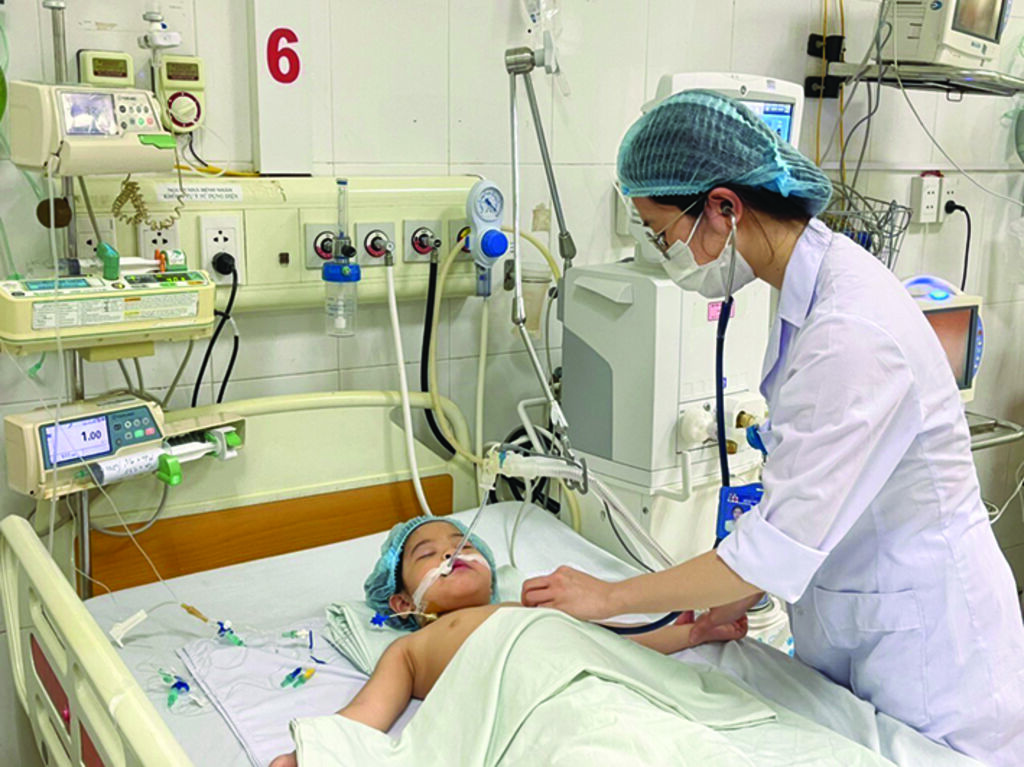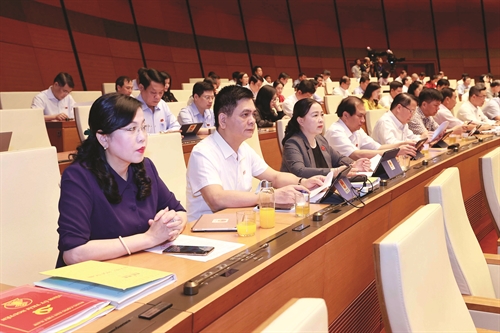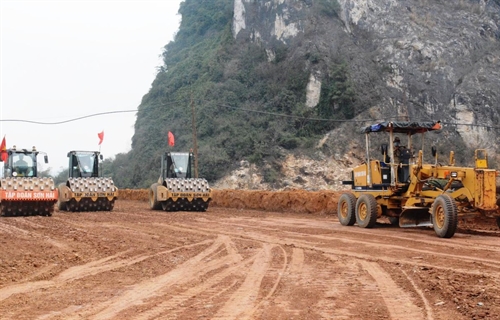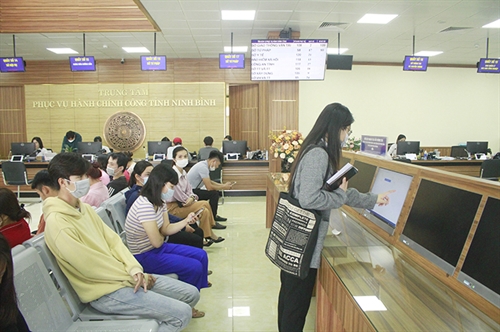Dao Hong Lan - Minister of Health
 |
| A child is receiving treatment at Thanh Hoa Pediatric Hospital__Photo: VNA |
The aging population, changing disease patterns, etc., have prompted the renewal of the medical system, in which improving healthcare institutions and policies constitute a central task to raise the quality of health care and protection for the people, ensuring their access to health care services.
The health care and protection for people constitute an important task and top priority of the Vietnamese State. Resolution 20-NQ/TW of October 25, 2017 of the 6th Plenum of the 12th Party Central Committee on “ Enhancing the protection, care and improvement of people’s health in the new situation” (Resolution 20-NQ/TW) has affirmed the goal of constantly heightening Vietnamese people’s health, stature, life span and living quality; ensuring that every citizen is entitled to health protection and care; to be equal in rights and obligations in participating in and benefiting from the health insurance and related services. With the efforts of the entire political system and the health sector as the core, the protection, care and improvement of the people’s health have obtained great results, thus greatly contributing to the national development.
Achievements of Vietnam’s health sector
Over the recent years, Vietnam’s medical system has been crowned with important achievements.
First, the medical system from the central to local levels has been constantly consolidated and developed. Primary healthcare activities, preventive medicine, and control of contagious and non-contagious diseases have been stepped up, promptly detecting, controlling and effectively handling health issues related to natural disasters, calamities, epidemics, including COVID-19. Every person can access quality basic medical services.
Second, the network of hospitals nationwide has been increasingly consolidated through investment with government bonds, socially mobilized resources and foreign aid projects, especially hospitals at district level and in difficulty-hit provinces. Hence, the quality of medical examination and treatment services has been constantly heightened, with many hi-tech services being widely provided, thus meeting the people’s higher and higher healthcare needs.
Third, Vietnam has recently applied different measures to renew the finance mechanism for the health sector, including the adoption of the National Assembly’s Resolution 18/2008/QH12 of June 3, 2008, on “Accelerating the implementation of socialization policies and laws in order to raise the quality of healthcare for people”, higher state budget spending for health care, and higher proportions of public expenditure on health care. The ratio of public financial spending to total expenditures for the health sector increased from 35 percent in 1998 to 49 percent in 2017 and 47.1 percent in 2020. The health insurance coverage has risen from year to year, currently at 92 percent of the national population. The medical service charges have been renewed towards calculating correctly all expenses; meanwhile, different solutions have been applied to support vulnerable groups such as free health insurance cards for the poor, under-six children and the elderly, co-payment of health insurance for poor and ethnic minority people, etc. Thereby, poor people in Vietnam can well access medical services, including hi-tech services, thus contributing to assuring equality in people’s health care.
Fourth, the health sector has applied various solutions to raising the quality of medical establishments’ operation, including the mechanism of autonomy in terms of finance, personnel and organizational structure to perform assigned tasks. The socialization policy has contributed to additionally mobilizing non-state budget resources for investment in medical establishments, raising service quality.
Fifth, the quality and quantity of medical personnel have been constantly improved. Different measures have been applied to sustainably develop health workers for difficult regions, such as nomination-based training and area-based training. Various solutions have been applied to attract health workers to work in mountainous, deep-lying and remote areas. By 2020, the doctor per 10,000 inhabitant ratio had reached 9.4 nationwide and more than 80 percent of the commune health stations had been staffed with physicians. Medical training establishments have been invested and upgraded for raising training quality. The Law on Medical Examination and Treatment, which was passed by the 15th National Assembly on January 9, 2023, and will take effect on January 1, 2024, is expected to enhance the management and raise the quality of medical personnel, including a new process of granting medicine practicing licenses.
With these achievements, almost all basic health indexes of Vietnam have reached the national objectives and the Millenary Development Goals as well as the Sustainable Development Goals to 2030, surpassing the average level of countries with the same average per-capita income level. Vietnam’s average life span has increased to 73.7; the maternal mortality rate dropped from 233/100,000 live newborns in 1990 to 43/100,000 live newborns in 2017; the mortality rate among children of under one year dropped from 36.9/1.000 alive newborns in 1990 to 16.9/1,000 alive newborns in 2017[2]. In 1990, the mortality rate among under-five children was 1/20, falling annually (1990-2016) by 3.3 percent nationwide. The malnutrition rate also reduced from 33.9 percent in 2007 to 18.1 percent in 2020[3]. The expanded vaccination program has been carried out at commune health stations since 1985, proving a success of the grassroots health network, without non-vaccination communes by 1995 in the whole country. Vietnam completely eliminated polio in 2000 and neonatal tetanus in 2005.
Difficulties and challenges in the new situation
First, the people’s healthcare needs have risen quantitatively and qualitatively. The disease pattern has changed with a rapid increase of non-contagious diseases, accidents and injuries. Some dangerous contagious diseases such as cholera, malaria and dengue fever are still at risk of outbreak. In addition, new and strange diseases have appeared unexpectedly and turned complicated such as SARS and SARS-CoV-2. Health risks related to environment, life style, climate change have not been well controlled yet.
Second, though the general health indexes are fairly good, the gaps between regions and zones and between population groups have been widened. The health conditions of people in mountainous, deep-lying, remote, and ethnic minority regions remain poor, especially the maternal mortality rate, the infant mortality rate, and the child malnutrition rate.
Third, the medical system and primary health care activities largely concentrate on treatment of sick people at medical establishments. Meanwhile, analysis of healthcare demand shows that only 20 percent of the sick people need to be hospitalized while the remaining 80 percent of slightly sick or non-sick people only need primary healthcare services, which are, however, not well provided. The service-providing capacity of grassroots-level medical establishments, especially commune health stations, is limited due to a lack of human resources, low professional qualifications of health workers, poor medical equipment and facilities, and a shortage of medicines, medical equipment and supplies. The treatment service-providing capacity of district-level health establishments[4]/commune health stations remain limited. The non-contagious disease combat program has failed to meet the demand, only attaching importance to treatment, not to the control of dangerous factors to prevent diseases.
Fourth, the medical finance remains insufficient in several aspects. The state budget sources for preventive medicine and grassroots health care activities in many localities are not ensured yet, especially for professional activities of commune health stations. The use of health insurance funds remains inefficient.
The current mode of medical service charge payment has failed to create a motive for improving service quality and to encourage the provision of primary healthcare services. Medical insurance only pays for medical examination and treatment services, not for preventive, counselling, health management, and disease-screening services due to the lack of payment sources. The medical service charges have been recently adjusted after 17 years, but only taking into account salary and direct expenses, not correctly and fully calculating all the expenses.
The capability to protect people from financial risks is not high. Expenses from the patients’ pocket money are high, posing a challenge to the sustainability of medical finance and the all-population medical coverage. A number of financial mechanisms and policies such as financial autonomy, socialization of financial sources should be early adjusted to avoid their adverse impacts, especially the abuse of medical services.
Fifth, the health sector’s human resources remain inadequate quantitatively and qualitatively and are distributed irrationally between levels, regions as well as professional fields, especially the shortage of physicians and pharmacists in rural, mountainous, deep-lying and remote areas. The number of physicians and nurses per 10,000 inhabitants remain low. In 2021, the physician per 10,000 inhabitant ratio was 9.4 (as compared to 11 physicians/10,000 inhabitants under Resolution 20-NQ/TW, and 19 physicians/10,000 inhabitants in the national master plan; the ratio of nurses to 10,000 inhabitants is also very low, only at 14.3. In addition, due to low incomes, unsatisfactory allowances, poor working conditions due to the shortage of medical equipment, unsafe working environment, few training opportunities, it is difficult to attract and retain health workers, especially in areas stricken by socio-economic difficulties, or in peculiar professions such as tuberculosis, leprosy, psychiatrics and forensic medicine.
Sixth, after the pandemic, the health sector faces many post-COVID-19 challenges such as the job quittance by many experienced, qualified medical staff at public medical establishments due to high working pressure and professional risks; the shortage of medicines, medical supplies and equipment at many medical establishments nationwide; poor administration and patient service in a number of medical establishments. The changing disease structure, larger population, impacts of COVID-19 pandemic, among others, have exerted an enormous pressure on healthcare activities.
Orientations for improving healthcare institutions and policies to ensure people’s right to access healthcare services
The priority objective of Vietnam’s medical system is to ensure that all people are in good health and each person is medically managed, being able to use comprehensive medical services when getting sick, without facing the financial burden to pay medical expenses. In order to promote the provision of services towards the objectives of fairness, efficiency and quality; meet the healthcare demands, ensure everyone’s right to access healthcare services, the improvement of medical institutions and policies in the coming period should focus on the following issues:
First, continuing to complete the system of institutions and regulations, ensuring a legal corridor the care of people’s health, focusing on the elaboration and submission of legal documents which are key to the operation of the sector, such as the Pharmacy Law (revised), the Health Insurance Law (revised), the Population Law, the Medical Equipment and Facility Law, and the Disease Prevention Law.
Second, renewing the organization and operational mechanism of the medical system towards developing and strengthening the grassroots system in providing the primary healthcare services at three professional-technical levels: primary medical examination and treatment; basic medical examination and treatment; and intensive medical examination and treatment, corresponding to proper functions and tasks as required by the professional level (not according to the current administrative levels). The primary health care is undertaken by commune health stations which play the role as the gatekeeper in the health care system. Clearly defining service-providing functions, tasks and scopes of every medical unit at each level, particularly clarifying the relationships between medical establishments in providing the medical services. It is necessary to determine the role and responsibility of hospitals in supporting the primary healthcare level in well performing the primary healthcare functions.
Third, renewing the mechanism of medical finance so as to create motivation for health workers in providing quality medical services, comprehensive and continuous care as well as enhancing the people’s accessibility to medical services and protecting people from financial risks due to medical expenses.
Fourth, elaborating policies on development of human resources for the health sector, such as a scheme on development of human resources for the health sector; reviewing regimes and policies applicable to medical professionals; planning the network of medical establishments in the 2021- 2030 period, with a vision towards 2050, etc.
Fifth, perfecting policies for higher quality and efficiency of medical examination and treatment; completing professional guidelines and processes to supervise and enhance service quality.-
[1] The Vietnamese version of this article was published on tapchicongsan.org.vn on July 9, 2023.
[2] According to the World Bank’s surveys (2019).
[3] According to the 2019-20 National General Nutrition Investigation conducted by the National Nutrition Institute (the Ministry of Health) in coordination with the General Office of Statistics (the Ministry of Planning and Investment) and with the assistance of international organizations: United Nations Children Fund (UNICEF), Food and Agriculture Organization (FAO), World Health Organization (WHO), World Bank (WB), IGN, CDC (United States), Institute of Research and Development (France), FHI360/FHI Solutions (Intake, Alive & Thrive), INDDEX Project, Tuffs University (the United States).
[4] The hospital bed occupancy capacity of a number of district-level hospitals is under 60 percent.









